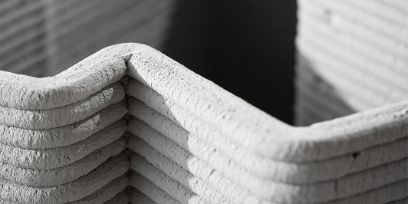- Research Project
3D concrete printing
When printing three-dimensional concrete objects, a specific type of software is needed to control the robotic printer. BFH has developed just such a “slicer” for the company Creabeton Matériaux.
Factsheet
- Institute(s) Institut für Drucktechnologie IDT
- Funding organisation Innosuisse
- Duration (planned) 01.11.2019 - 30.04.2022
- Head of project Manuel Aeschbacher
- Partner Creabeton Matériaux
Starting Point
Using 3D printing to create three-dimensional objects made out of concrete is challenging. This is because concrete has completely different properties than those found in plastics or metals. It needs to be freshly mixed and processed in as fluid a state as possible, but also needs to quickly solidify after coming out of the printer nozzle so that its shape is not altered by the next layer of concrete. Another feature of concrete printing is that it is difficult to pause the printing process as the concrete at the tip of the nozzle hardens rapidly, potentially damaging it beyond repair. Because of this and other limitations, concrete printers need to be controlled using software that differs substantially from conventional “slicers” for metal or plastic printers. On behalf of the company Creabeton Matériaux, the BFH Institute for Print Technology is developing slicer software designed especially for concrete printing.
Approach
The job of the slicer is to generate operation commands for the robot and other control signals on the basis of the digital model of the object to be printed. To this end, the model first needs to be cut virtually into layers (known as slicing). Each layer consists of individual points that can be merged into polygons. Each polygon corresponds to a complete path for the robot. The more polygons there are per layer, the wider the printed object will be. Once all of the polygons in a layer have been completed, the robot will start working on the next layer up.
Solution
The slicer developed by BFH represents the digital interface between the 3D model and the robotic printer. Using the CAD data of the model and taking into account the material properties and other parameters, it plans the printing path and sends commands to the robotic printer.
Creabeton Matériaux has already used the 3D printer to produce a variety of concrete objects for its customers. The process is particularly attractive for one-off items or very small batches where the high cost of manufacturing a mould would push up the unit price.
